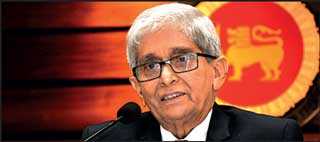Tuesday Dec 24, 2024
Tuesday Dec 24, 2024
Friday, 9 April 2021 00:20 - - {{hitsCtrl.values.hits}}
 |
| Central Bank Governer Prof. W.D. Lakshman - Pic by Lasantha Kumara |
Buoyed by signs the economy is turning the pandemic corner, the Central Bank yesterday kept its policy rates unchanged continuing a two-year cycle of easing but pledged to remain vigilant of any demand side pressures as growth recovery gains ground.
The Monetary Board, at its meeting on Tuesday, decided to maintain the Standing Deposit Facility Rate (SDFR) and the Standing Lending Facility Rate (SLFR) of the Central Bank at their current levels of 4.50% and 5.50%, respectively.
The Board arrived at this decision after carefully considering the macroeconomic conditions and expected developments on the domestic and global fronts, Central Bank Governor Prof. W.D. Lakshman told reporters.
He added the Central Bank remains committed to maintaining the low interest rate structure, thereby ensuring continued support for a sustained economic recovery, in the context of the prevailing low-inflation environment and well-anchored inflation expectations.
“The Board observed the stronger-than-expected growth performance towards the end of 2020 and underscored the need for maintaining the prevailing low interest rate structure to support the sustained economic recovery in the period ahead.”
The Census and Statistics Department, releasing growth numbers for 2020 in March, calculated the economy had contracted by 3.6%, marginally less than the projected 3.9%.
The Central Bank will continue to monitor domestic and global macroeconomic and financial market developments and stand ready to take proactive measures to help the economy to sustain the growth trajectory, while maintaining inflation in the targeted 4%-6% range under the flexible inflation targeting framework.
Pointing to the shrinking trade deficit that has continued in January and February due to import reductions and an uptick in manufacturing and service industries, Prof. Lakshman was confident that Sri Lanka could meet its growth target of 5.5%-6% growth for 2021.
He also touched on strong worker remittances, tourism recovery and foreign investment expected from Port City underpinned by the Government’s focus on supporting domestic production, as moving the country towards a holistic recovery.
“Reflecting the impact of monetary policy easing measures adopted thus far, most market interest rates declined to their historic lows. Nevertheless, some upward pressure on yields on Government securities was observed recently, in contrast to monetary policy expectations. Thus, the Central Bank reiterates the necessity to maintain the low interest rate structure, amidst the significantly high excess liquidity in the domestic money market, thereby facilitating the take-off of domestic investment.”
The Governor indicated that the Central Bank would maintain its policy easing measures, which began in 2019, and insisted moratoriums and liquidity injections helped support COVID-19-hit businesses and keep them afloat during a difficult pandemic year.
“Credit to the private sector expanded notably thus far in 2021, reflecting the impact of growth-supportive policies. We are focused on keeping this moving forward and will remain vigilant of any supply side pressures that may emerge,” he added.
Growth of credit extended to the private sector gathered pace in February 2021. This momentum is expected to continue, supported by low lending rates, surplus liquidity in the domestic money market and the expected rise in lending to micro, small and medium enterprise (MSME) sector. Credit to the public sector, particularly net credit to the Government, from the banking system continued to grow, resulting in a notable expansion of domestic credit and an acceleration of broad money growth.
Inflation is expected to remain subdued in the near-term and any upward pressures over the medium term could be mitigated, to a large extent, by the envisaged supply side improvements.
The gradual easing of domestic food prices and subdued demand conditions in the economy are likely to support subdued inflation in the near term. However, pressures on inflation could emerge over the medium term due to the envisaged improvements in aggregate demand conditions and the projected recovery in global commodity prices, among others. Such pressures could be neutralised to a large extent by the envisaged improvements on the supply side over the medium term.
As per the World Economic Outlook (WEO) of the International Monetary Fund (IMF) in April, global growth in 2020 was estimated to have recorded a lower-than-expected contraction of 3.3%, reflecting the faster recovery of economic activity during the second half of 2020 underpinned by extraordinary policy support.
Global growth projections were revised upwards to 6% in 2021 and 4.4% in 2022. The pace of economic recovery varies across regions and countries, reflecting the differences in the speed of vaccine rollout, the degree of economic policy support and structural features.
The Sri Lankan economy rebounded notably from the effects of the COVID-19 pandemic. As per the GDP estimates published by the Department of Census and Statistics, the contraction of the Sri Lankan economy at 3.6% in 2020 was lower than initial projections.
Despite the second wave of COVID-19 in the country, the Sri Lankan economy grew by 1.3% in the last quarter of 2020 from a year earlier. Supported by the growth-conducive environment made possible by the accommodative monetary and fiscal policies, the successful containment of the spread of COVID-19 locally, and the stronger-than-expected recovery of leading trading partners, the economy is expected to record a high growth momentum in the medium term.
